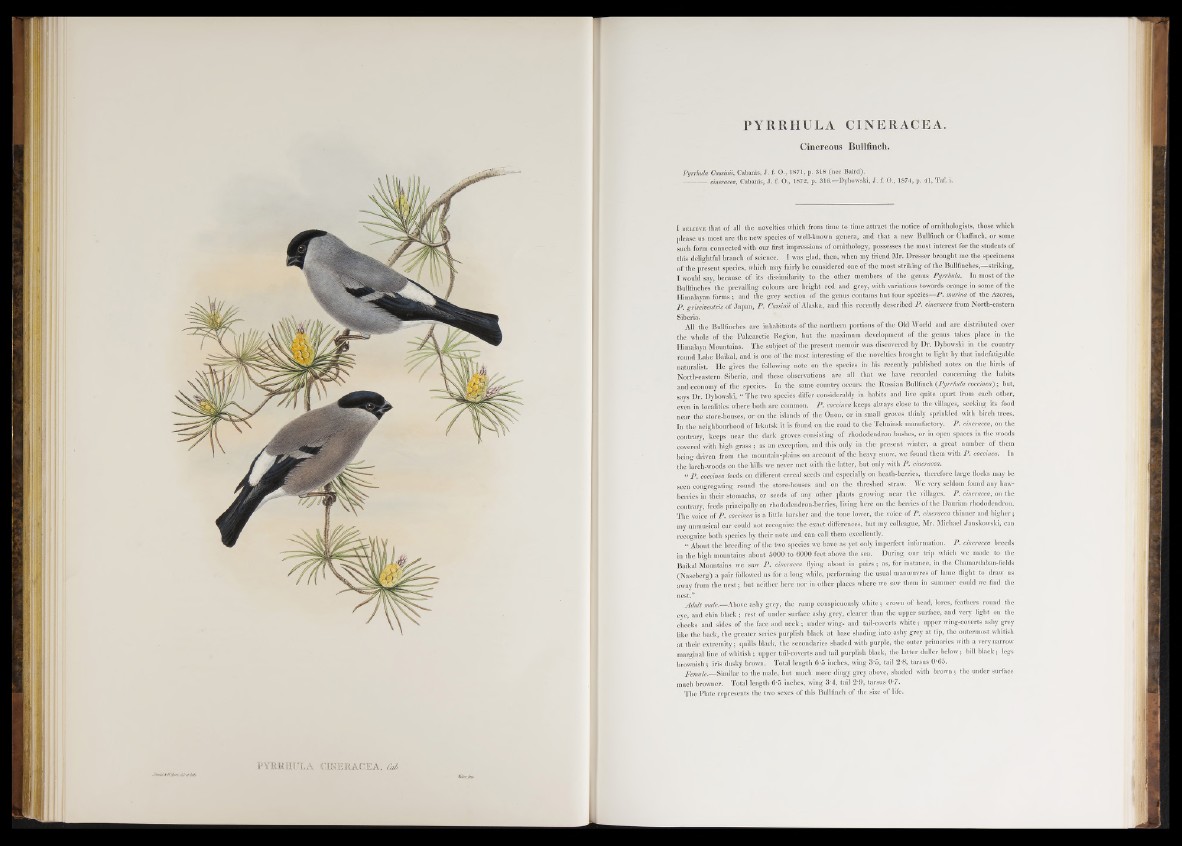
PYRRHULA CINERACEA.
Cinereous Bullfinch.
Pyrrhula Cassinii, Cabanis, J . f. 0 ., 1871, p. 318 (nee Baird).
-— cineracea, Cabanis, J. f. O., 1872, p. 316.—Dybowski, J . f. 0 ., 1874, p. 41, Taf. i.
I b e l ie v e that of all the novelties which from time to time attract the notice of ornithologists, those which
please us most are the new species of well-known genera, and that a new Bullfinch or Chaffinch, or some
such form connected with our first impressions of ornithology, possesses the most interest for the students of
this delightful branch o f science. I was glad, then, when my friend Mr. Dresser brought me the specimens
of the present species, which may fairly be considered one o f the most striking o f the Bullfinches,—striking,
I would say, because of its dissimilarity to the other members o f the genus Pyrrhula. In most of the
Bullfinches the prevailing colours are bright red and grey, with variations towards orange in some of the
Himalayan forms ; and the grey section of the genus contains but four species—P . murina of the Azores,
P . griseiventris of Japan, P . Cassinii o f Alaska, and this recently described P . cineracea from North-eastern
Siberia.
All the Bullfinches are inhabitants of the northern portions of the Old World and are distributed over
the whole of the Palæarctic Region, but the maximum development o f the genus takes place in the
Himalaya Mountains. The subject of the present memoir was discovered by Dr. Dybowski in the country
round Lake Baikal, and is one of the most interesting of the novelties brought to light by that indefatigable
naturalist. H e gives the following note on the species in his recently published notes on the birds of
North-eastern Siberia, and these observations are all that we have recorded concerning the habits
and economy of the species. In the same country occurs the Russian Bullfinch (Pyrrhula coccínea') ; but,
says Dr. Dybowski, “ The two species differ considerably in habits and live quite apart from each other,
even in localities where both are common. P . coccínea keeps always close to the villages, seeking its food
near the store-houses, or on the islands of the Onon, or in small groves thinly sprinkled with birch trees.
In the neighbourhood of Irkutsk it is found on the road to the Telminsk manufactory. P . cineracea, on the
contrary, keeps near the dark groves consisting of rhododendron bushes, or in open spaces in the woods
covered with high grass ; as an exception, and this only in the present winter, a great number of them
being driven from the mountain-plains on account of the heavy snow, we found them with P . coccínea. In
the larch-woods on the hills we never met with the latter, but only with P . cineracea.
“ P . coccinea feeds on different cereal seeds and especially on heath-berries, therefore large flocks may be
seen congregating round the store-houses and on the threshed straw. We very seldom found any haw-
berries in their stomachs, or seeds of any other plants growing near the villages. P . cineracea, on the
contrary, feeds principally on rhododendron-berries, living here on the berries of the Daurian rhododendron.
The voice of P . coccinea is a little harsher and the tone lower, the voice of P . cineracea thinner and higher ;
my unmusical ear could not recognize the exact differences, but my colleague, Mr. Michael Janskowski, can
recognize both species by their note and can call them excellently.
I About the breeding of the two species we have as yet only imperfect information. P . cineracea breeds
in the high mountains about 5000 to 6000 feet above the sea. During our trip which we made to the
Baikal Mountains we saw P . cineracea flying about in pairs ; as, for instance, in the Chamardaban-fields
(Naseberg) a pair followed us for a long while, performing the usual manoeuvres of lame flight to draw us
away from the nest ; but neither here nor in other places where we saw them in summer could we find the
nest.”
Adult male.—Above ashy grey, the rump conspicuously white ; crown of head, lores, feathers round the
eye, and chin black ; rest of under surface ashy grey, clearer than the upper surface, and very light on the
cheeks and sides of the face and neck ; under wing- and tail-coverts white ; upper wing-coverts ashy grey
like the back, the greater series purplish black at base shading into ashy grey at tip, the outermost whitish
at their extremity ; quills black, the secondaries shaded with purple, the outer primaries with a very narrow
marginal line of whitish ; upper tail-coverts and tail purplish black, the latter duller below ; bill black ; legs
brownish ; iris dusky brown. Total length 6 '5 inches, wing 3-5, tail 2-8, tarsus 0'65.
Female.—Similar to the male, but much more dingy grey above, shaded with brown ; the under surface
much browner. Total length 6'5 inches, wing 3 4, tail 2*9, tarsus 0 -7 .
The Plate represents the two sexes of this Bullfinch of the size of life.